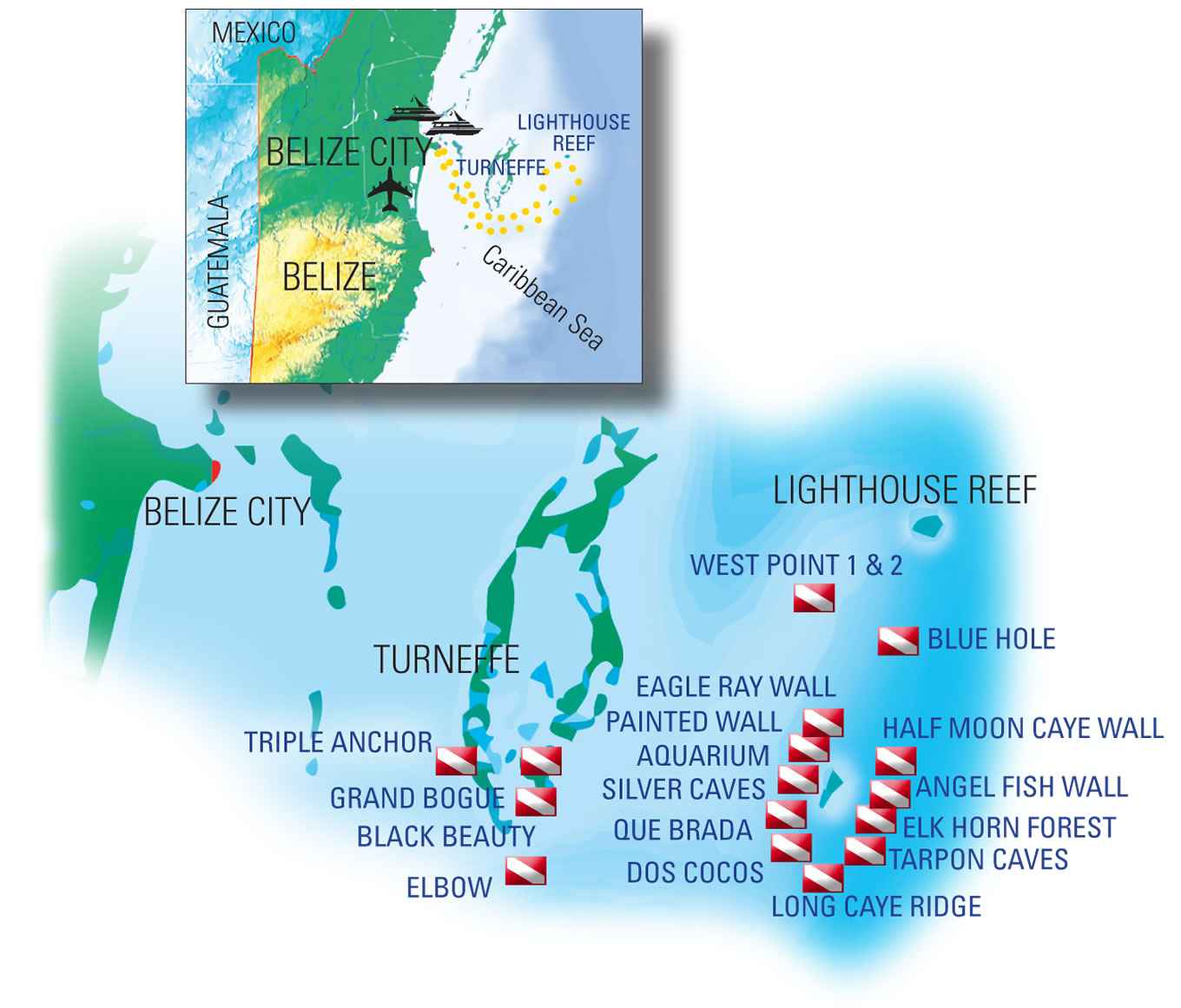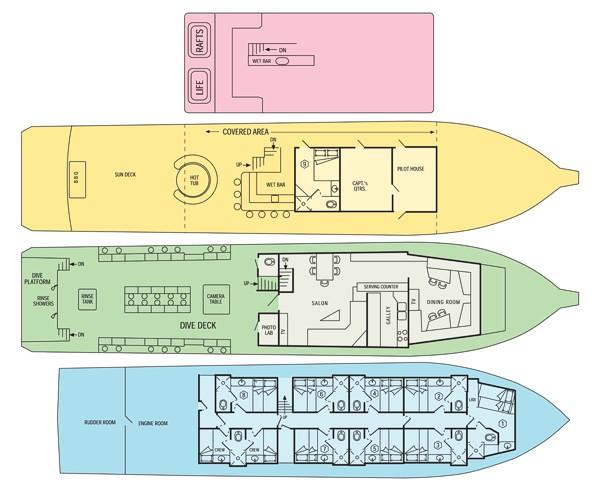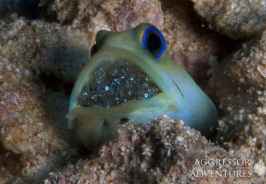Belize Aggressor III
The 110-foot Belize Aggressor III has nine spacious and expertly fitted cabins. The master cabin has a double bed and a closet. Seven of the cabins have a lower double and an upper single berth and one two single berths. All cabins have private bathrooms, hair dryers and televisions with DVD players.
The dive deck has personal gear lockers with in-place air and Nitrox fill stations, rinse tanks and a camera table with low-pressure air hoses. The large dive platform has two warm freshwater showers and two water exit ladders. For relaxing between dives, the partially covered sundeck features a wet bar, CD equipment and a hot tub. Inside, the lounge has plenty of room to stretch and watch movies, listen to music and work with your digital photography. There is also a computer station with email access and a dinghy for shore excursions.
Local food specialties and Western fare are prepared by a trained chef and served buffet style in the galley. All beverages, including beer and wine, are free of charge. MV Belize Aggressor III diving facilities include a huge dive deck with personal gear bins, air/nitrox fills, rinse tanks and a three-tiered camera table with low-pressure air hoses, camera rinse tank and E-6 photo lab.
Diving on the Belize Aggressor III begins Sunday morning and ends Friday at lunch. There will be up to 5 dives each day as well as night dives. Belize is renowned for its magnificent wall diving. Sheer walls like Painted Wall, Half Moon Caye Wall and Quebrada are encrusted with massive gorgonians and orange elephant ear sponges hiding Moray eels, spiny lobsters and crabs. Another popular dive site is the Blue Hole, a collapsed freshwater cave system approximately 300m wide and over 120m deep. Jacques Cousteau declared the Blue Hole one of the top ten dive sites in the world. The Belize Aggressor III takes scuba divers to these spectacular sites along with many other stunning dive sites, year round.
Top Dive Sites - Belize
Angel Fish Wall
Belize Dive SitesMany friendly Grey angel fish give this site its name. The top of the wall teems with small fish. Eagle rays and an occasional shark cruise the wall.
Aquarium
A sheer drop-off begins around 30’, with an abundance of fish life at the top. About 40’-60’ deep along the wall are large baffel sponges, giant deep water sea fans, and the richest collection of deep water gorgonians almost anywhere in the world. Giant elephant ear sponges, yellow tube sponges and azure vase sponges make this a very colorful area. Comical groupings of spotted truck fish are often seen on top of the wall, and the very corner of this reef is a very good place to see reef sharks, big black groupers, swirling schools of horse eyed jacks and hawksbill or green sea turtles.
Black Beauty
Known for sightings of turtles and eagle rays, this area features long mounds of coral with sandy bottom channels. Wall begins around 50 feet.
Blue Hole
The world’s largest blue hole, it was made famous by Jacques Cousteau in the 1970’s. The first shelf of this collapsed underground cavern begins at 110’. Here stalactites descend from the ceiling. A healthy reef exists around the edge of the blue hole and is home to an abundance of juvenile sea life, as well as schools of parrot fish, squid, flaming scallops and several varieties of angel fish. These shallows are great for diving or snorkeling.
Cathedral
Colorful formations resembling cathedral steeples with sandy cuts in between signify this site. This site is home to many black groupers and jacks, as well as three species of angel fish, scorpion fish, several varieties of eels and silver sides. Spanish dancers are sometimes sighted on the night dives.
Eagle Ray Wall
More arrow blennies that you will probably see anywhere else, plus loads of decorator crabs.
Elbow
This advanced dive boasts one of the best opportunities to see large pelagics such as eagle rays and reef and hammerhead sharks. Strong currents are often present.
Elk Horn Forest
Located on the east side of Long Caye, the shallows grow large mounds of lettuce leaf coral that projects towards the depths. In the shallows are elk horn corals inhabited by numerous species of juvenile fish.
Grand Bogue
This site is home to the elusive white spotted, white lined and large-eyed toadfish.
Half Moon Caye
Weather Permitting, the BELIZE AGGRESSOR III™anchors just off the caye. Guests are shuttled to the island and enjoy a relaxing walk along the beach to the bird sanctuary. Here you can observe red footed booby birds and frigate birds from observation deck built at the canopy level. Located on the east end of the island is an historic light house built in 1848, which by the way is the lighthouse for which the atoll is named. The guests may have the opportunity to snorkel with several nurse sharks around the docks of this tropical island.
Half Moon Caye Wall
Marked by tunnels and grooves which slope down toward the open water, several different species of grouper and snapper can be seen in the tunnels. Just off the wall, one can spot eagle rays, sharks and turtles.
Long Caye Wall
Named for a protruding ridge of reefs and numerous swim throughs with grooves which cut the wall running directly to the open sea. Interesting soft corals and sponges are abundant here, and many eels are found here, as well.
Painted Wall
There are many clusters of small painted tunicates, within the depths of 40 - 70’. These walls have shallows inhabited by species of parrot fish, black durgeon, queen trigger fish, and many more. The sheer walls begin around 25’ and are overhung in many places with black coral trees and rope sponges covered with light bulb tunicates.
Que Brada
Named for a cut in the reef (the wall and shallows), this is an extremely sheer and active stretch of wall. Because it projects out into the current, the extra flow of plankton around it supports an incredibly rich diversity of marine animals. Green moray eels, spotted drum, lobster, crabs, and tarpon on the night dives.
Silver Caves
The large swim through is frequently inhabited by thousands of silver sides, and the vertical wall starts in only 35’ of water. Lots of big black groupers collect under the boat, as do the ubiquitous school of horse-eyed jacks, yellow tailed snappers, and Creole wrasses.
Tarpon Caves
A tall reef buttress rises straight up from the whitest powder sand to within 30’-35’ of the surface and is honeycombed with caves and cuts. This vertical wall is covered with huge yellow tube sponges, black coral trees and monster barrel sponges projecting from the many small ledges. The sand areas are rich in garden eels, midnight parrot fish, razor fish and southern stingrays. Tarpon patrol the inside edge of the reef. This dive site features several tunnels and chimneys in which tarpon and grouper like to hide.
Triple Anchor
Three anchors are very well hidden on a beautiful reef in 45-feet of water. Look for big Barrel Sponges, Eagle Rays and a cleaning station.
West Point 1 & 2
The visibility at these sites is highly dependent upon winds and tides, but the labyrinth of reef buttresses makes this site great even when visibility is down. The walls are very vertical and start in only 20’ - 25’ of water. Loads of black coral and deep water gorgonians abound, as do giant barrel sponges and red finger sponges. You are likely to see mangrove tunicates here. The shallow sandy area is alive with garden eels, peacock flounders, and southern stingrays. In the sandy areas, blue throated pike blennies can be found.
Wreck of the Sayonara
Remains of a 50’ boat with coral growth around the wreck and numerous barrel sponges, along with many other sponge varieties.


